THE EXPERT MATHEMATICIAN
New leverage in middle school mathematics education
Frequently Asked Questions!

Fig.1 — Mathematics, Gr. 8. National Assessment of Educational Progress
US test scores reveal that 2 of every 3 middle school students are not achieving proficiency in 8th grade math.
Figure 1 addresses this question. But why does this seem to be an intractable problem? Cognitive science based research, summarized below, helps to answer this question.
Peer reviewed, randomized, controlled research shows significant increases in both achievement and positive attitudes regarding study of mathematics. The main TEM site exhibits these data.
A student-centered, collaborative, peer-interactive model.
Traditional NCTM scope and sequence of mathematics content.
Its Generative Learning Advantage mathematical coding utility.
Most sub-proficient 8th grade students will fail standard 9th grade algebra and many will leave school. Even with “credit recovery” classwork that can lead to a high school diploma, few of these students will succeed in algebra or have adequate preparation for post-secondary technical studies that could lead to well-paying employment.
Black and Hispanic students, proportionally, are the most vulnerable, followed closely by other minorities. Fifty six percent of white students achieve proficiency or higher.
Black-White math achievement gap: 1990–2019
Trajectories reveal nearly parallel paths, except recently as Black scores decline more than those of Whites. These remarkably similar patterns—just at different achievement levels—seem to suggest systemic nationwide trends in capacity of instructional resources to engage students—as if indexed at different levels by societal factors. Fig. 2

Conditions of Achievement
Academic handicap: cognitive science perspective
Barriers to learning: a social-emotional-cognitive view.
Ability to concentrate varies with level of social-economic status; as SES declines, worries about life circumstances, and stress, tend to increase—thus hampering executive functions which regulate
attention. Fig. 3.
As stress increases, so, too, do physical and psychological discomfort, further distracting the mind, diminishing executive functions and ability to concentrate—again, feeding back to, and amplifying, internal stress, thus debilitating selective attention needed for achievement. Where daily classroom requirements for clear focus and mindful practice are imposed—but feel untenable to the student—the stress cycle is further amplified, often resulting in further decreasing interest, oppositional behavior and/or conflict with authorities, feeding back to, and adding to, stress. In the world of neuroscience, this is referred to as a (downward spiraling) vicious cycle.


Control orientation—internal vs. external—and motivation.
The dire consequence of these internal dynamics is that hopefulness is undermined with withering effects on willingness to exert effort. Fig. 4. According to the NAEP long term trend results, effectively, this consequence screens 2/3 of US students from post-secondary technical training and well-paying technical employment opportunities.
Increasing leverage in the mathematics classroom
Considering all that compromises disadvantaged students’ executive functions, compensatory advantages are needed—especially in mathematics—that can restore cognitive focus, ability to succeed and the motivation to do so that follows.
To help distracted students succeed they must be engaged—and feeling successful—from day 1 and throughout a grading period in rigorous standards based mathematical activity. Middle school math teachers know the challenge of generating this classroom spirit.
To establish interest that supports engagement, instruction that is student-centered and peer-interactive while keeping to the boundaries of standard math prescriptions shows great promise—especially so if students can dynamically operate mathematical tools to generate and apply lesson content to solve problems, while helping one another in doing so.
The goal of this instructional approach is to support students in becoming self-determined learners. The illustration below depicts a scene in which students of The Expert Mathematician are engaged in this way. TEM maps well onto Self-determination Theory that identifies 3 innate psychological needs that are universal across humanity—and, when satisfied, support feelings of well-being and enthusiasm for life. In the classroom, this translates to clear thinking, harmonious relations, focus and motivation. The real sense that “we are being successful together”.
The 3 dimensions of SDT are: genuine sense of competence that individuals mainly generate for themselves; and also relatedness.
Struggling math students rarely if ever feel competent in grade level mathematical activities. Yet, when they are given control of a formal mathematics generator, with a peer reading instructions to generate and operate, in real time, a mathematical expression, a sense of competence quickly arises. There is no better math utility than Logo for doing this (more information on the main site). Light acknowledgement by the teacher, “Yes, you did that; can you explain how you got this result?” Teachers will follow up with a little lite facilitation as needed to help students fill in conceptual links.
How can students feel autonomous when lessons are prescribed? Just as we do not personally build the vehicle we drive to work—we do operate it; and if we are able to do so safely getting to the next destination, we can feel autonomously competent. This is true for use of any tool. Logo’s generative property supports excellent accessibility to the nuances and strict subtleties of mathematics, distinguishing it from any other mathematical tool. Logo enables learners to feel a genuine sense of autonomy as they generate and operate the essential expressions of each mathematical lesson.
What does it take to achieve proficiency in 8th grade math?
Minimally, mathematics content must be appropriate. TEM’s content aligns well with the NCTM’s middle school Principles and Standards for School Mathematics. Equally important, a student must be sufficiently interested in the subject to engage and persist to proficiency.
Given sufficient interest—whether the interest is intrinsic or a result of persuasion—barriers to achievement must feel surmountable. Many students arrive in middle school inadequately prepared for increasingly higher level math—and not hopeful that sustained effort could bring success. Many of these students fear being further humbled by what they perceive as a constant stream of concepts and formal logic that they cannot understand.
Thus for the 85% of Black students and 78% of Hispanics who top out at Basic or Below Basic in 8th grade math, nationally, a unique mix of instructional resources is needed to support them to higher achievement.
The Expert Mathematician middle school mathematics curriculum has shown promise in meeting this daunting challenge. Designed to maximize interest, TEM incorporates several features that naturally activate interest—while also making accessible the complex nuances and intricacies of formal mathematical logic. These features are a more readable literary register, collaborative learning, and a computer math utility that provides a generative learning advantage.
TEM acknowledges that many students who struggle with formalized instructional media cannot relate to the upper level “literary register” of formalized texts. Yet text-based material is important for detailing the fine logical distinctions of concepts and computational procedures. For these students a more colloquial literary register makes lesson instructions more accessible.
People are social. We can be at our best in dealing with life’s complications when we are constructively engaged with others. Students working together with one peer in separate but complementary roles, while practicing several key interactive skills, and using a computer to operate an engaging mathematical utility, can accomplish more than if they were trying to work independently. There is a robust theory of interdependence that speaks to the value of collaborative problem solving. Some students interact constructively more naturally than others, so TEM program guidelines recommend initially teaching—and routine reinforcement of—several key skills, such as actively listening, waiting your turn, staying in your role, complementing your partner. A “token economy” can be used to reinforce these skills. More information is provided in the main site—and in the Guidelines for Teaching TEM pdf.
Students use the Logo formal mathematical logic generator in every lesson to generate, operate and apply mathematical expressions and solve problems. The greatest value of Logo’s integrated math coding and geometry features can be realized in basic education as an engaging tool that students can use to create and apply visual and operational standard mathematics lessons, gaining dynamic access to mathematical logic and concepts to take ownership of their mathematical learning. Routine use of The Expert Mathematician program has been found to be highly motivating, even for many at-risk students who have previously shunned math learning.
Conducting The Expert Mathematician learning community
Additional information is contained in the main site page and the downloadable, Guidelines to Teaching TEM document—both accessed by logging in, below.
The mathematics microculture. Learning the tools and terms and practices of the microculture.
The Expert Mathematician program was developed as an academic challenge intervention that integrates a set of relevant and well-established theories of learning and teaching, with customized lesson media, that combine to increase opportunities for both teachers and students to achieve improved outcomes. Conducted as designed, TEM enhances authentic confidence of students and teachers, translating to motivation, engagement and learning.
Students with 6th grade reading skills should be able to understand lesson instructions. One important advantage of student-centered learning is that students have some control of lesson pacing. This feature enables the learner to pause as needed to grasp a concept, before dashing on—an added benefit in deciphering technical literature. Respecting this need of disadvantaged students is important—not to let them drift off too long, but acknowledging that many of these students have never understood some logical or semantic terms that a teacher might take for granted. So students seeming “adrift” may simply need more time to process a lesson element in terms of their existing knowledge. They should be encouraged to “give it your best thinking,” but also know that the teacher will be around to help with a needed clarification.
Working with a peer and with Logo and perhaps a little coaching, they can fill them in.
Preparing to conduct class. Teachers must actively work through lessons before assigning them to students. Lesson preparation is important for two reasons:
- Awareness of lesson content and objectives, so any confusion can be confidently facilitated to clarity.
- Readiness to raise interesting questions related to the lesson content—such as, “if you change this constant (or variable input), what is the mathematical result?” Then (gently probing, while expecting to coach or nudge with a hint), “Can you see why you got that result?” Following up with a brief intervention, drawing from rehearsed Big Ideas in mathematics, can deepen students’ understanding of a concept and—importantly—help them to make connections between the present item of study and prior concepts. Big Ideas in mathematics are further discussed with sources in the main site page and the downloadable Guidelines for Teaching TEM, following sign-in below.
“This is all problem-solving”, one successful teacher of TEM, commented. But it’s engaging and with teacher’s lighthearted support and reinforcement of students’ use of collaborative skills (each student doing their part; and—if needed—use of reward tokens with weekly drawing for small prizes), students will increasingly make the effort and they will learn. Using Logo has its own rewards: as noted, students can feel mathematically competent like they never have previously.
Scheduling classes: Period or block? Organizationally, there’s a lot going on in The Expert Mathematician learning community. Students need enough time to pick up their materials, get settled, and begin work. Time should be allotted for students to write out, work, and turn in a couple of calculation problems before starting on the day’s lesson. To establish momentum, allowing students enough time to actively engage their lesson is important. A single 45–50 minute class period is scarcely enough time for thoughtful engagement and teacher support. Ninety minute block scheduling is strongly encouraged.
Background theories at work. Pedagogy, theory, social-cultural tools ZPD and “tools” should be leading facilitative process (contrast with content) Fine-tuning the collaborative peer interdependence part will carry the challenging days. Gentle reminders that, “we are in this together; we help each other succeed” (coupled with checklist reinforcement) will be reassuring. And, you will see Vygotsky’s social-cognitive theory in practice. Many students understand this (intuitively) from a team sport; that’s one microculture. Now they are practicing bringing these skills into the culture of mathematical practice that will be useful in the world of work.
Of disadvantaged students you are asking a lot, so it’s important to be directive in getting set up and starting lessons, but then lighthearted and patient in cultivating peer work habits and the “growth mindset” as students process mathematical ideas.
Teachers also check in briefly with students to determine their comprehension, facilitating students to correct understanding of lesson points, as needed.
Calculation skills. Students jump right into lessons. When routines have been established, they begin to practice computational skills. Students should have some choice in which skills to practice, but they should try to keep their choices consistent with concept lessons. They should activate and operate a game, write out the problem on a half sheet of paper and do the calculation on paper to deduce the answer. The answer is then keyed in to check accuracy. Although students are working together, they should each do two different problems and hand them in. Calculation proficiency is important but should not delay working through the lessons to learn and apply concepts to solve problems. This is a major strength of the program. If sessions are limited to 40 minutes, getting settled, picking up their folder, getting started need to happen fast. Ninety minute block scheduling works better.
Following is a still-life cameo of students at work and teacher reinforcing skills practice.
Looking Ahead
Fourth grade achievement of minority and low income students significantly lags white achievement and declines further by grade 8 on the NAEP.
Middle school is really the last chance to help Basic and Below Basic students to recover confidence and generate the foundations needed to succeed at least in algebra 1 principles. Students who feel competent at that level will be able to carry forward their growth mindset in mathematics to technical training or OJT apprenticing, possibly later in their secondary studies or following high school graduation.
Conducted as designed, The Expert Mathematician experience can move them along this path.
Right click Download Now button and choose Save As Link to obtain poster. It can be printed at 11 x 17 in.
Are you in? If so, please sign in with a school email address to move to the main site for further information and downloadable files that include software, a tutorial and sample lessons.

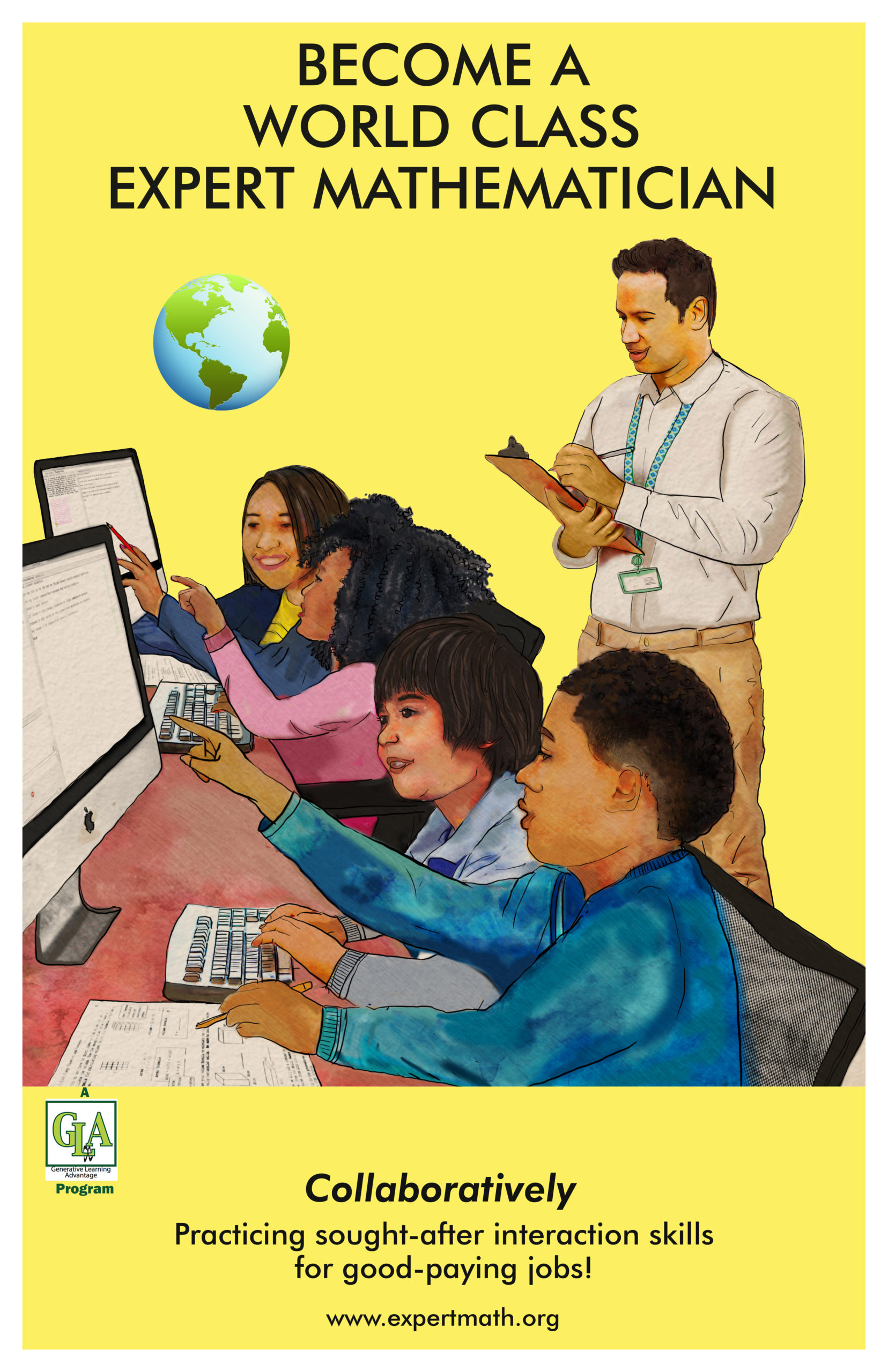
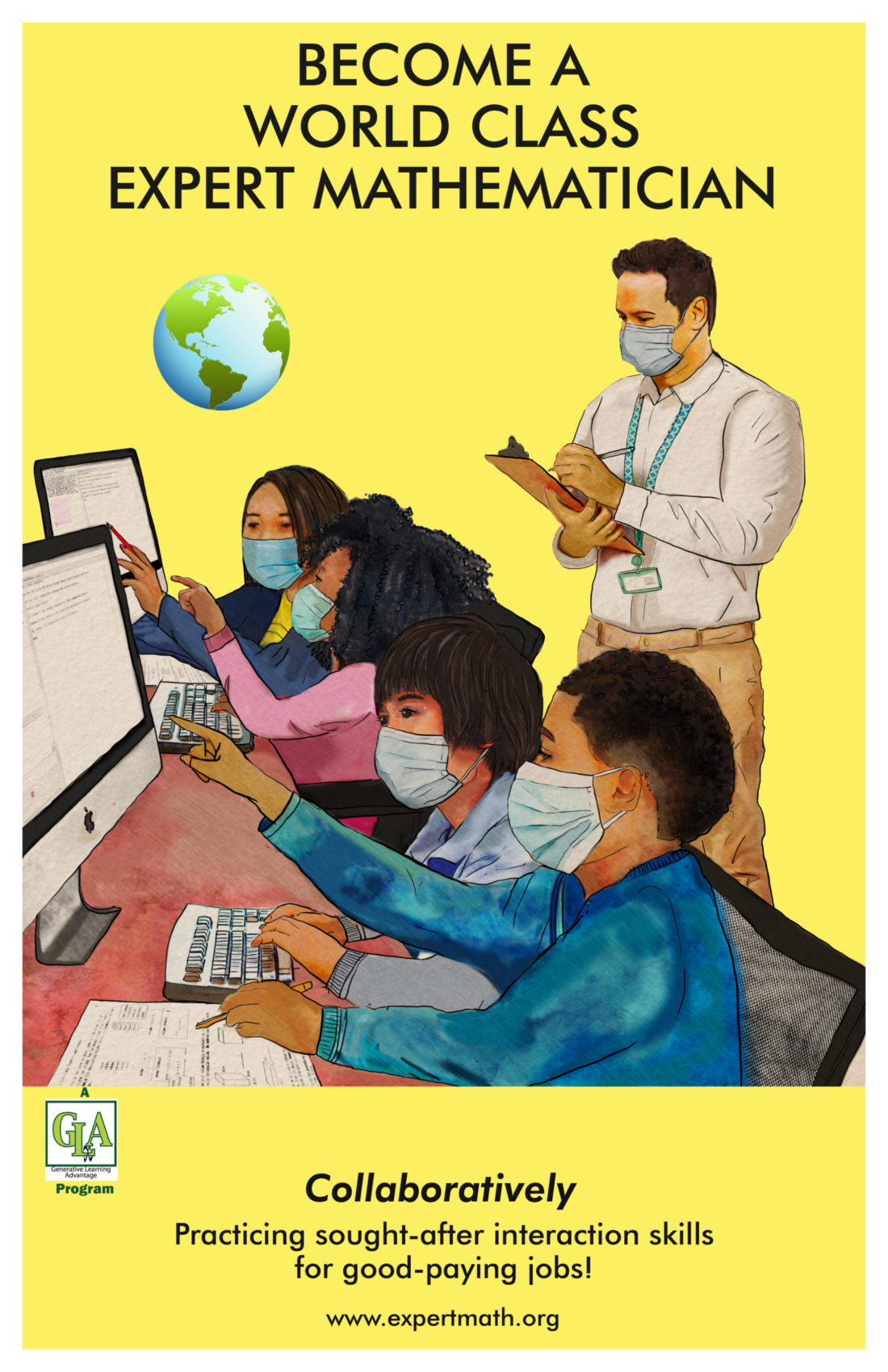
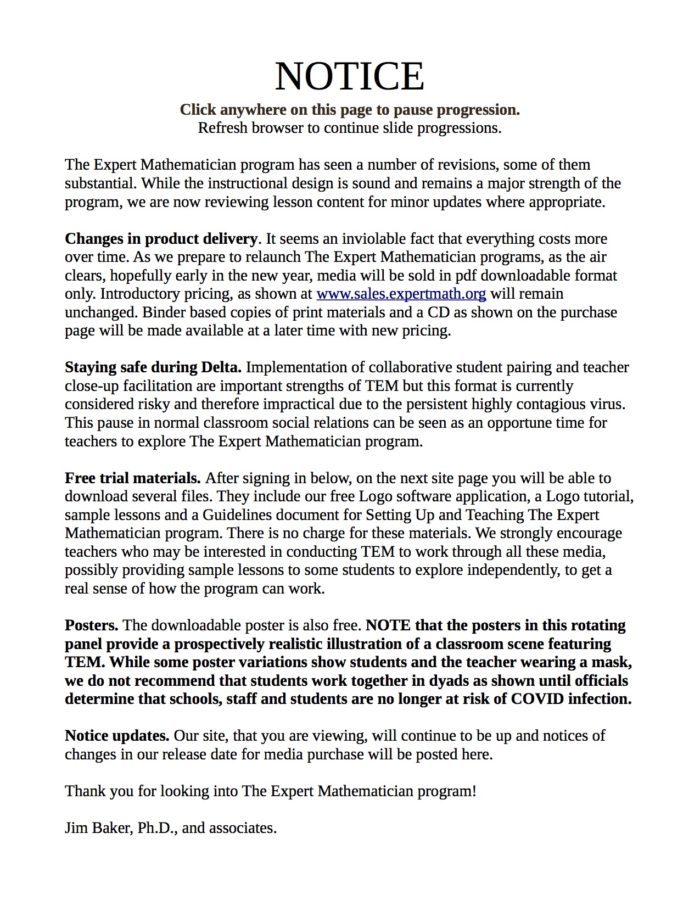
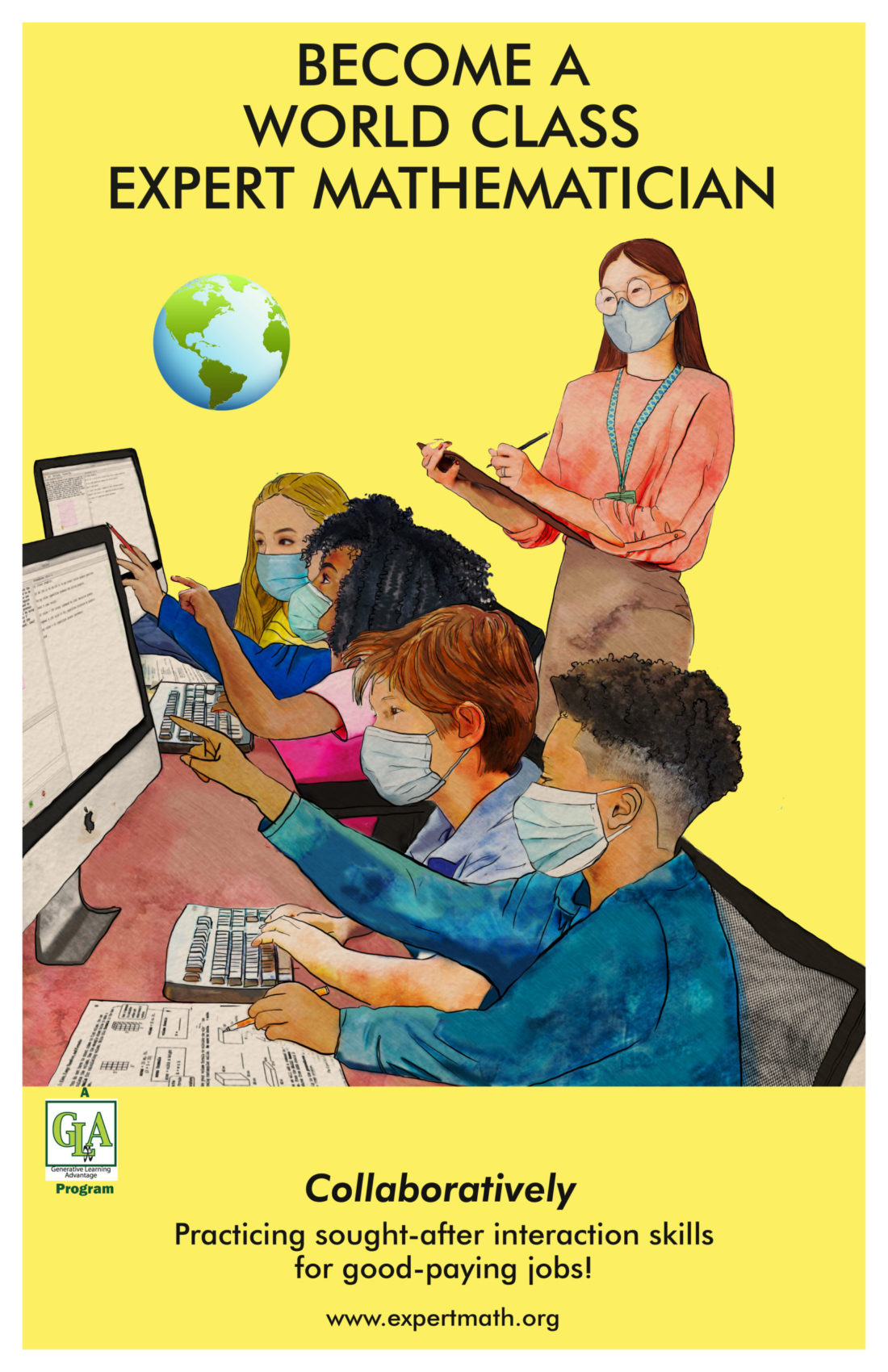
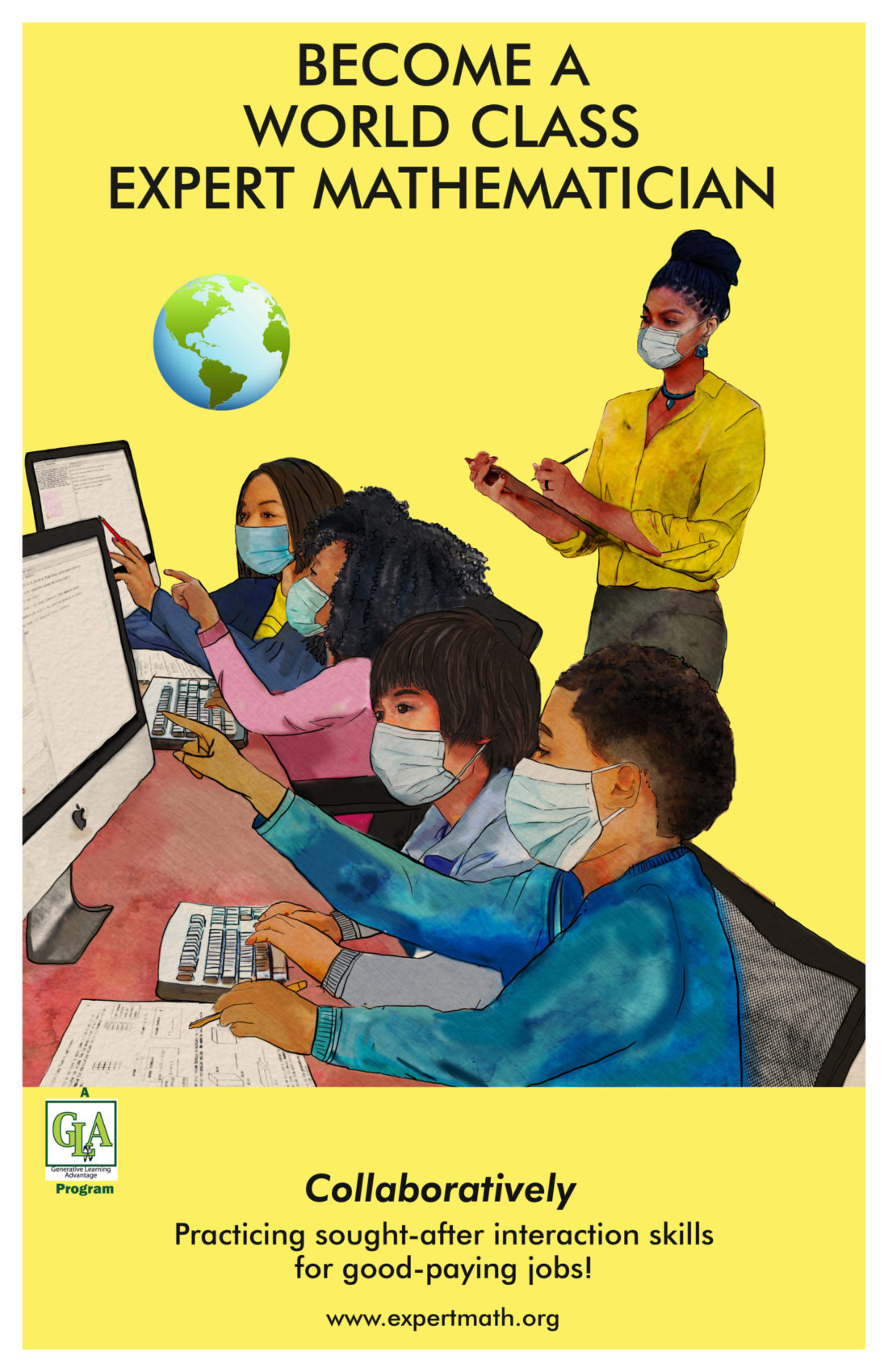
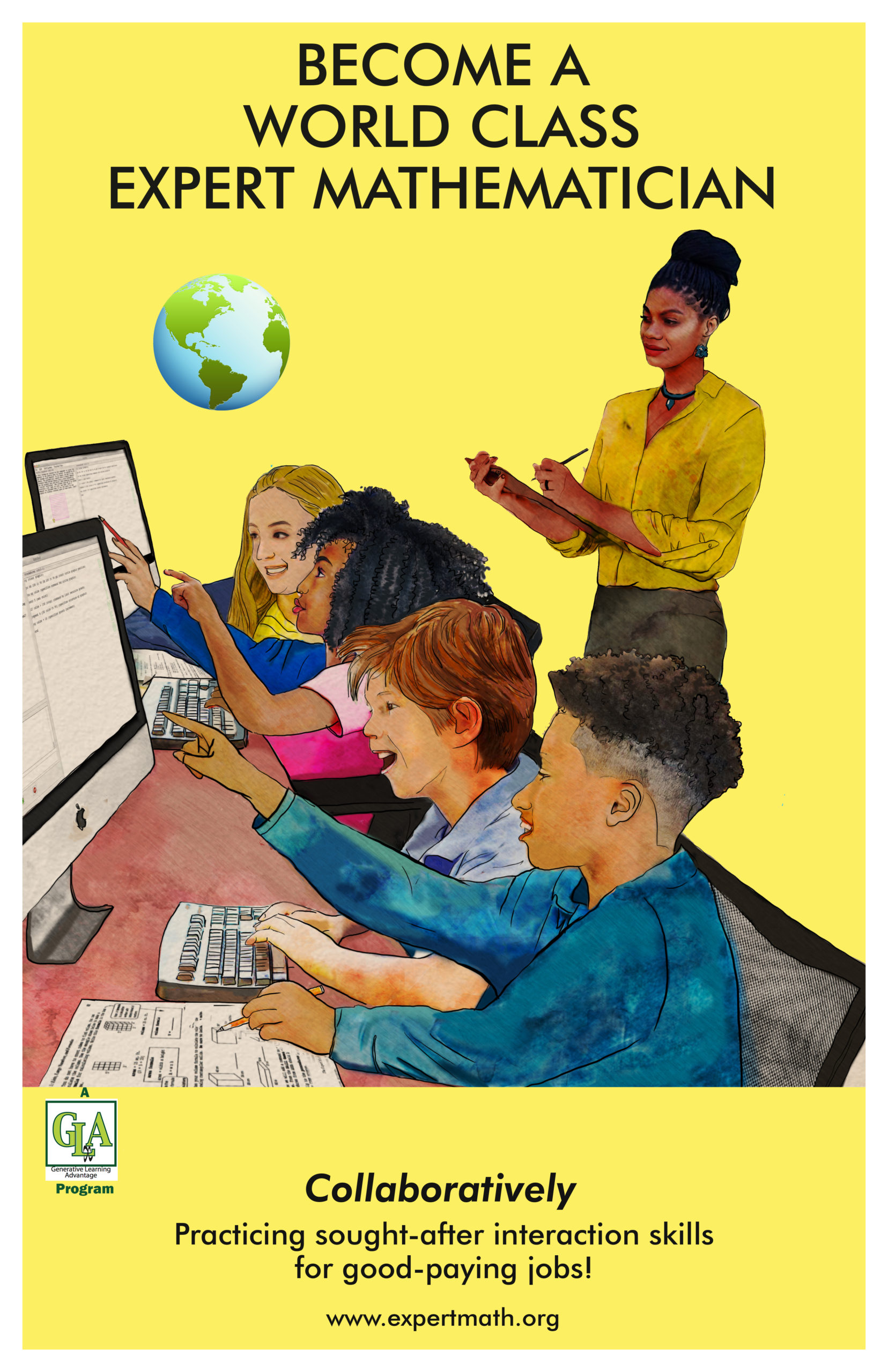
Copyright James Baker, 2020,2021. All rights reserved. No portion of this page may be copied or distributed without written permission from the author.
